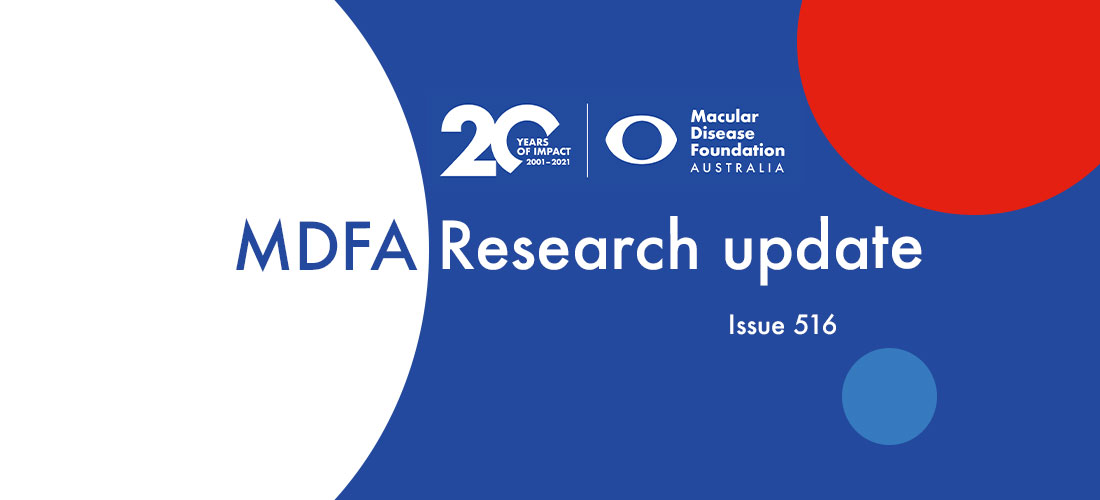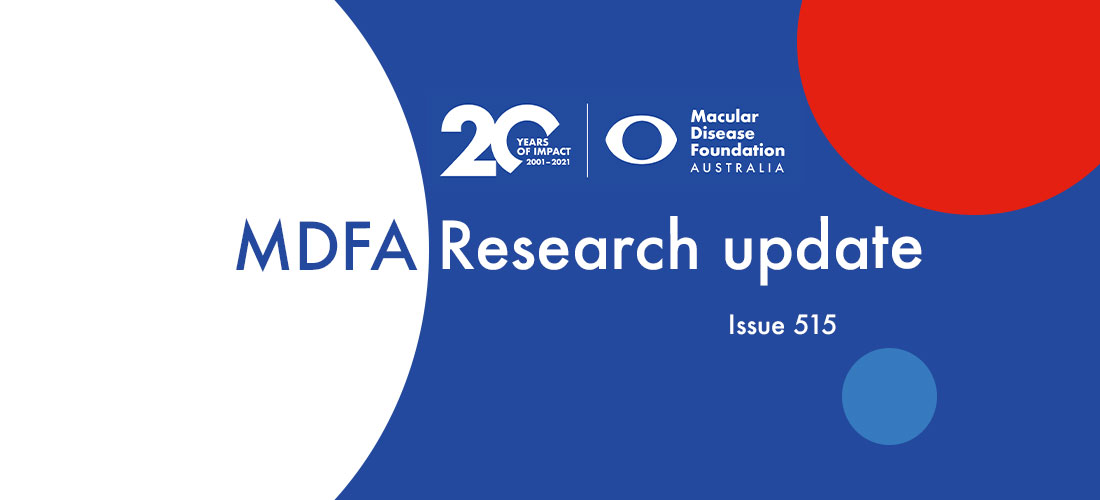FEATURED ARTICLE
Evaluating the Occurrence of Rare Variants in the Complement Factor H Gene in Patients with Early-Onset Drusen Maculopathy
JAMA Ophthalmol.2021 Oct 14.
Anita de Breuk, Thomas J Heesterbeek, Bjorn Bakker, Timo Verzijden, Yara T E Lechanteur, Caroline C W Klaver, Anneke I den Hollander, Carel B Hoyng
Importance: Early-onset drusen maculopathy (EODM) is a severe disease and can lead to advanced macular degeneration early in life; however, genetic and phenotypic characteristics of individuals with EODM are not well studied.
Objective: To identify genotypic and phenotypic characteristics of individuals with EODM.
Design, setting, and participants: This case-control study collected data from the European Genetic Database from September 2004 to October 2019. A total of 89 patients with EODM diagnosed at 55 years or younger and 91 patients with age-related macular degeneration (AMD) diagnosed at 65 years or older were included.
Exposures: Coding regions of CFH, CFI, C3, C9, CFB, ABCA4, PRPH2, TIMP3, and CTNNA1 genes were sequenced, genetic risk scores (GRS) were calculated based on 52 AMD-associated variants, and phenotypic characteristics on color fundus photographs were analyzed comparing patients with EODM and AMD.
Main outcomes and measures: GRS, frequency of rare genetic complement variants, and phenotypic characteristics.
Results: This case-control study included 89 patients with EODM (mean [SD] age, 51.8 [8.7] years; 58 [65.2%] were female) and 91 patients with AMD (mean [SD] age, 77.6 [6.1] years; 45 [49.5%] female). At a mean (SD) age of 56.4 (7.3) years, 40 of 89 patients with EODM (44.9%) were affected by geographic atrophy or choroidal neovascularization. A lower GRS was observed in patients with EODM compared with patients with AMD (1.03 vs 1.60; P = .002), and 27 of 89 patients with EODM (30.3%) carried rare variants in the CFH gene compared with 7 of 91 patients with AMD (7.7%). Carriership of a rare CFH variant was associated with EODM (odds ratio, 7.2; 95% CI, 2.7-19.6; P < .001). A large macular drusen area (more than 50% covered with drusen) was observed in patients with EODM (24 of 162 eyes [14.8%]) compared with patients with AMD (9 of 164 eyes [5.5%]) (odds ratio, 4.57; 95% CI, 1.5-14.1; P = .008).
Conclusions and relevance: A large proportion of patients with EODM in this study carried rare CFH variants, with most of the identified CFH variants clustered in the first 7 complement control protein domains affecting factor H and factor H-like 1. Because EODM frequently leads to advanced macular degeneration at an early age and can result in many years of vision loss, this study supports targeting the complement system and sequencing the CFH gene in patients with EODM to improve genetic counseling and future treatments for AMD.
DOI: 10.1001/jamaophthalmol.2021.4102
DIAGNOSIS & IMAGING
Novel metrics for evaluating decision making in a ‘Treat and Extend’ regimen for neovascular age related macular degeneration
Eye (Lond).2021 Oct 12.
Bethan McLeish, Anna Morris, Meena Karpoor, Tehmoor Babar, Niro Narendran, Yit Yang
Background: The primary aim was to investigate outcome of the decision making on duration of injection intervals between injection visits over the first 2 years of a treat and extend regimen.
Method: Consecutive patients receiving Aflibercept for treatment naïve neovascular age-related macular degeneration between 01.01.2016 and 15.07.2017 were identified from our departmental register. Retrospective data collected on all visits over 24 months were classified into three groups: (A) Without Interval Decision Events (IDE)” Injection only” (B) IDE resulting in injection intervals of <5 weeks and (C) IDE resulting in intervals of >5 weeks. The primary outcome was number of successful IDE relative to the total visits in Group C. Successful decision making was defined as absence of worsening of visual acuity (>5 L) or central retinal thickness (>50 microns) at the subsequent visit. Secondary visual and anatomical outcomes at 24 months were also evaluated.
Results: Data from 56 eyes of 50 patients were included in the study. Visual acuity improved by +7.11 L at 24 months. Forty one patients with unilateral therapy made 721 visits: 280 visits (38.8%) were group A; 164 visits (22.8%) were group B and 277 visits (38.4%) were group C. Average interval in Group C was 8.9 weeks (range 5-15). The success rate of extension was 95.31% (264/277 visits).
Conclusion: These metrics for evaluating the decision making aspect of disease activity monitoring may be useful for monitoring performance and have given us a more realistic view and expectations of what can be achieved using this regime to optimise the timing of injections.
DOI: 10.1038/s41433-021-01785-7
Comparison of Visual Function Tests in Intermediate Age-Related Macular Degeneration
Transl Vis Sci Technol.2021 Oct 4;10(12):14.
Robyn H Guymer, Rose S Tan, Chi D Luu
Purpose: Identifying the most sensitive functional measure in intermediate age-related macular degeneration (iAMD) could help select an appropriate test for monitoring disease progression and evaluating the efficacy of novel interventions for the early stages of AMD. The purpose of the study was to determine which commonly used visual function test is the most discriminatory when comparing individuals with iAMD to normal participants.
Methods: In this prospective observational study, iAMD cases and healthy controls underwent visual function testing (best corrected visual acuity (BCVA), low luminance visual acuity (LLVA), mesopic microperimetry, dark adaptation, and scotopic perimetry following photobleach), clinical eye examination, and multimodal retinal imaging in a single study visit. The data of each functional parameter were converted into z-score so that all the parameters had a common scale to allow a direct comparison between different functional parameters.
Results: Forty-eight subjects (23 normal control, 25 iAMD) participated. Although all five parameters showed a significant reduction in function in iAMD eyes compared to controls (P ≤ 0.003), the rod intercept time (RIT) detected the greatest reduction in function followed by the scotopic sensitivity, mesopic sensitivity, BCVA, and LLVA, with the absolute mean z-score of 4.5, 2.2, 1.0, 1.0, and 1.2, respectively.
Conclusions: Among the five visual function parameters commonly used, RIT is the most discriminatory functional parameter in the early stages of AMD.
Translational relevance: The RIT could be considered for assessing visual function and evaluating efficacy of novel interventions aimed at improving retinal function in eyes with early stages of AMD.
POTENTIAL TREATMENTS
Therapeutic potential of PGC-1α in age-related macular degeneration (AMD) – the involvement of mitochondrial quality control, autophagy, and antioxidant response
Expert Opin Ther Targets.2021 Oct 12.
Juha M T Hyttinen, Janusz Blasiak, Pasi Tavi, Kai Kaarniranta
Introduction: Age-related macular degeneration (AMD) is the leading, cause of sight loss in the elderly in the Western world. Most patients remain still without any treatment options. The targeting of Peroxisome proliferator-activated receptor gamma coactivator 1-alpha (PGC-1α), a transcription co-factor, is a putative therapy against AMD.
Areas covered: The characteristics of AMD and their possible connection with PGC-1α as well as the transcriptional and post-transcriptional control of PGC-1α are discussed. The PGC-1α-driven control of mitochondrial functions, and its involvement in autophagy and antioxidant responses are also examined. Therapeutic possibilities via drugs and epigenetic approaches to enhance PGC-1α expression are discussed. Authors conducted a search of literature mainly from the recent decade from the PubMed database.
Expert opinion: Therapy options in AMD could include PGC-1α activation or stabilization. This could be achieved by a direct elevation of PGC-1α activity, a stabilization or modification of its upstream activators and inhibitors by chemical compounds, like 5-Aminoimidazole-4-carboxamide riboside, metformin, and resveratrol. Furthermore, manipulations with epigenetic modifiers of PGC-1α expression, including miRNAs, e.g. miR-204, are considered. A therapy aimed at PGC-1α up-regulation may be possible in other disorders besides AMD, if they are associated with disturbances in the mitochondria-antioxidant response-autophagy axis.
DOI: 10.1080/14728222.2021.1991913
REVIEWS
Ocular Therapeutics and Molecular Delivery Strategies for Neovascular Age-Related Macular Degeneration (nAMD)
Int J Mol Sci.2021 Sep 30;22(19):10594.
Aira Sarkar, Vijayabhaskarreddy Junnuthula, Sathish Dyawanapelly
Abstract
Age-related macular degeneration (AMD) is the leading cause of vision loss in geriatric population. Intravitreal (IVT) injections are popular clinical option. Biologics and small molecules offer efficacy but relatively shorter half-life after intravitreal injections. To address these challenges, numerous technologies and therapies are under development. Most of these strategies aim to reduce the frequency of injections, thereby increasing patient compliance and reducing patient-associated burden. Unlike IVT frequent injections, molecular therapies such as cell therapy and gene therapy offer restoration ability hence gained a lot of traction. The recent approval of ocular gene therapy for inherited disease offers new hope in this direction. However, until such breakthrough therapies are available to the majority of patients, antibody therapeutics will be on the shelf, continuing to provide therapeutic benefits. The present review aims to highlight the status of pre-clinical and clinical studies of neovascular AMD treatment modalities including Anti-VEGF therapy, upcoming bispecific antibodies, small molecules, port delivery systems, photodynamic therapy, radiation therapy, gene therapy, cell therapy, and combination therapies.
CASE REPORTS
Myopic macular pits: A case series with multimodal imaging
Can J Ophthalmol.2021 Oct 6;S0008-4182(21)00348-3.
Meira Fogel Levin, K Bailey Freund, Gunnemann Frederic, Giovanni Greaves, SriniVas Sadda, David Sarraf
Purpose: To characterize the multimodal retinal findings of myopic macular pits, a feature of myopic degeneration.
Methods: A case series of patients with myopic macular pits were studied with multimodal imaging including color fundus photography, fundus autofluorescence (FAF), near infrared reflectance (NIR), spectral domain optical coherence tomography (OCT), optical coherence tomography angiography (OCTA), fluorescein angiography (FA) and indocyanine green angiography (ICG).
Results: Nine eyes of 6 patients with myopic macular pit were examined. Four patients presented with multiple pits and 3 with bilateral involvement. All pits were localized in a region of severe macular chorioretinal atrophy associated with myopic posterior staphyloma. In 3 eyes, the entrance of the posterior ciliary artery through the sclera was noted at the base of the pit. Schisis overlying the pit or adjacent to the pit was identified in 3 patients.
Conclusion: Myopic macular pits are an additional rare sign of myopic degeneration, developing in regions of posterior staphyloma complicated by severe chorioretinal atrophy and thin sclera.
DOI: 10.1016/j.jcjo.2021.09.003
Subretinal Neovascular Membrane in Wet Age-Related Macular Degeneration Managed with Intravitreal Ranibizumab
Cureus.2021 Sep 1;13(9):e17642.
Tanishq S Sharma, Shashikant M Sharma
Abstract
This case report depicts how a case of the subretinal neovascular membrane was managed with intravitreal ranibizumab injections. A 59-year-old female patient presented with complaints of diminution of vision in her right eye for one month. Various necessary examinations were carried out and the patient was diagnosed with both forms of age-related macular degeneration (ARMD) disorder – wet ARMD in the right eye and dry ARMD in the left eye. Pseudophakia was also seen in both eyes. Drusen deposits, characteristic of the disorder, were seen in the macular area of the oculus sinister (OS). The patient was treated for the wet ARMD with intravitreal injections of 0.5 mg ranibizumab administered one month apart in the right eye. The patient showed improvements in her visual acuity and a complete resolution of the subretinal fluid.
DOI: 10.7759/cureus.17642








